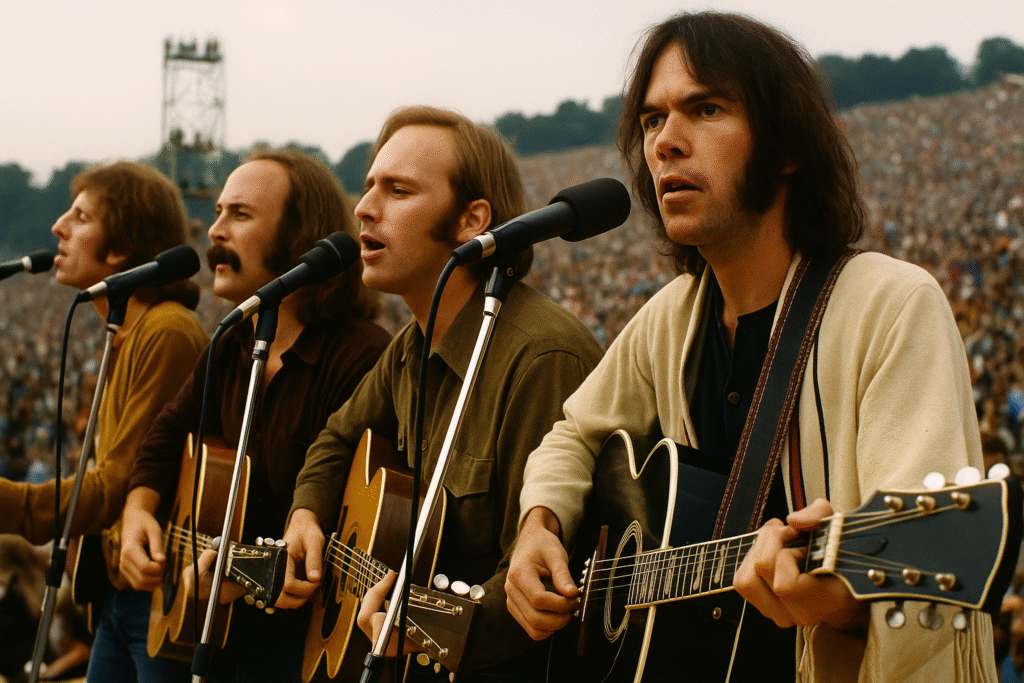AI-generated image for illustrative purposes.

Crosby, Stills, Nash & Young: A Nervous Debut That Made History
On Sunday afternoon, August 17, 1969, a fresh but untested group walked onto the Woodstock stage—one that would soon become one of the most respected names in American folk rock: Crosby, Stills, Nash & Young. Formed only a few months earlier, the quartet had made their official debut just days before at a show in Chicago. Woodstock would be one of their first real tests before a massive crowd.
David Crosby, Stephen Stills, and Graham Nash already carried weighty résumés—Crosby from The Byrds, Stills from Buffalo Springfield, and Nash from The Hollies. The addition of Neil Young, with his searing guitar tone and restless personality, gave the band a razor’s edge between delicate harmonies and raw rock punch.
Even so, nerves were high. Before striking the first chord, Stephen Stills admitted, “This is only our second gig, and we’re scared to death.” But the audience never sensed hesitation—what they heard was a blend of voices that seemed to transcend the festival’s chaos.
Songs like Suite: Judy Blue Eyes enchanted the crowd with its intricate vocal interplay, while Wooden Ships, co-written by Crosby, added a darker hue, reflecting both the fear of war and the yearning for escape. Amid the mud and madness, it became a rare moment of calm and spirituality.
The Defining Moment
Suite: Judy Blue Eyes—long, delicate, and luminous—showcased the quartet’s magic. Each voice felt like an instrument, weaving a soundscape almost unheard of in rock. The song won over even those who had resisted folk until then.
The Band: Folk Elegance at Woodstock’s Core
Right after CSN&Y, The Band took the stage. If there was a group capable of distilling America’s rural tradition into music, it was this one. Having backed Bob Dylan in previous years, Robbie Robertson, Levon Helm, Rick Danko, Richard Manuel, and Garth Hudson had already proven their worth with Music from Big Pink (1968), a record that blended country, blues, and gospel into something deeply original.
At Woodstock, The Band brought exactly that rooted sound. Songs like The Weight and Chest Fever resonated like timeless hymns, conjuring not urban rebellion but the raw soul of America’s heartland. For a crowd that had been dancing, shouting, and losing itself in psychedelia, this was a rare moment of contemplation.
No pyrotechnics. No guitar fireworks. Just exceptional musicians playing as if on a front porch—while the Bethel field hushed to listen. It may have been the festival’s most “sober” set, but it was no less powerful.
The Defining Moment
The Weight, sung in unison by the audience, turned Woodstock into one giant sing-along. Its simplicity contrasted with the event’s overwhelming scale—and that contrast made it unforgettable. It felt like everyone was sitting around the same campfire.
Harmony and Roots Amid the Chaos
If Santana and Janis had driven Woodstock to peak intensity, CSN&Y and The Band provided the counterpoint: harmony, spirituality, and roots. Proof that the festival wasn’t just about excess—it also offered moments of pause, where music invited reflection.
The contrast between pure, crystalline harmonies and the mud-soaked, makeshift stage gave these shows an almost mystical aura.
Burning Questions
Why were CSN&Y so nervous at Woodstock?
Because it was only their second official show. They weren’t sure if their chemistry would hold up in front of such a massive crowd.
Did Neil Young fully take part in the performance?
Yes—but controversially. He refused to be filmed and banned cameras during his set, which is why he barely appears in the official documentary.
Was The Band well-received?
Very much so. Though not explosive, their set was seen as one of the most refined of the festival, cementing their place as folk-rock icons.
Was “The Weight” already well-known in 1969?
Yes. Released in 1968, it had already earned critical acclaim, but at Woodstock it took on the aura of a popular anthem.
— Lena Blaze, Rock Vaults
